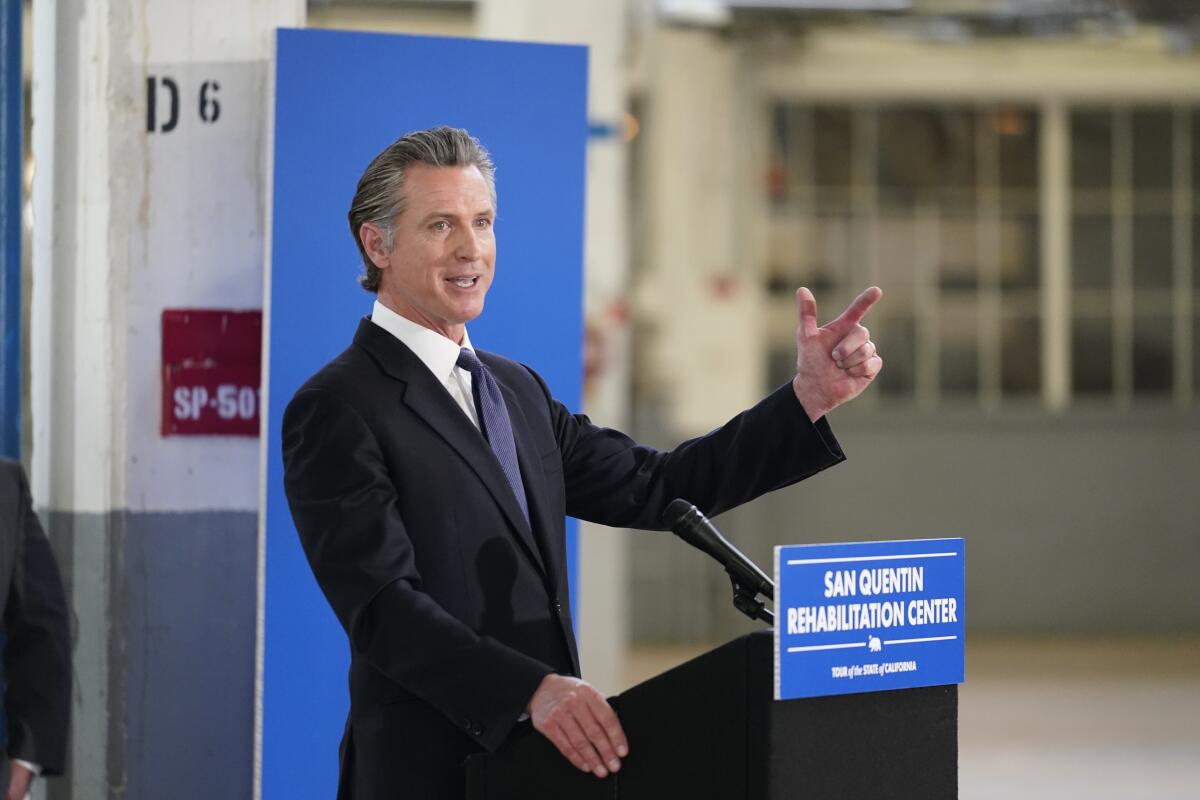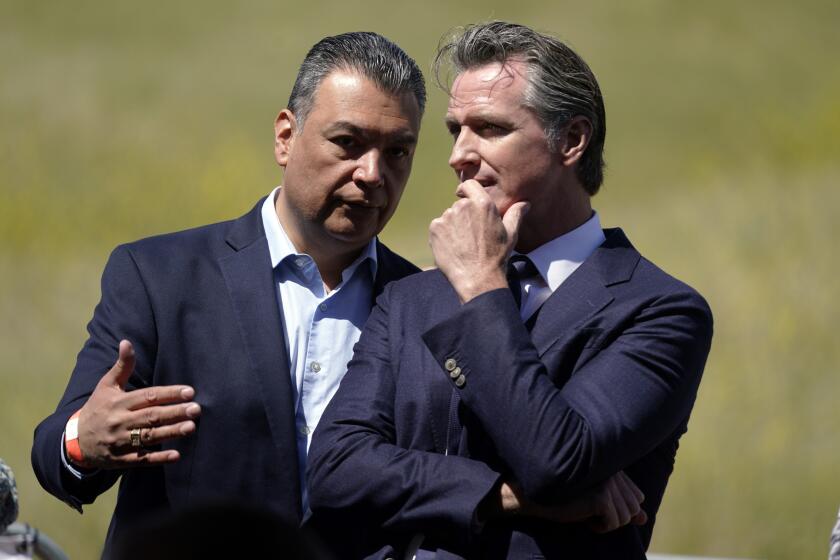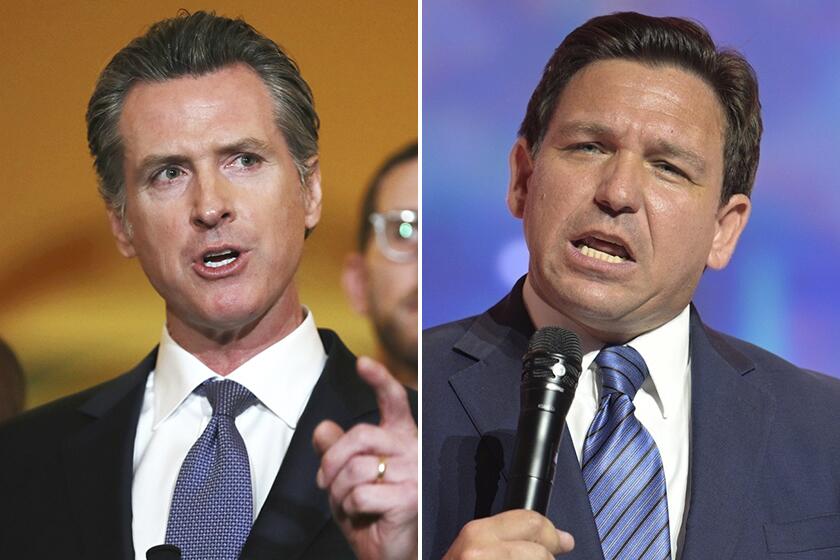New poll finds that California voters disapprove of Newsom’s performance as governor

- Share via
SACRAMENTO — Gov. Gavin Newsom’s standing among California voters has hit an all-time low, with 49% disapproving of his performance as governor, according to a new UC Berkeley Institute of Governmental Studies poll co-sponsored by the Los Angeles Times.
The survey showed Newsom’s popularity has tumbled this year as he continues to amplify his national profile and campaign outside of the Golden State to support President Biden and attack Republican governors and their conservative political agendas.
Newsom’s approval rating was 44% in the late October poll, an 11-point slide from February when 55% of voters approved of his performance. His disapproval among California voters increased 10 percentage points from earlier this year.
“He’s kind of taking on a new persona,” said Mark DiCamillo, director of the Berkeley poll and a longtime California pollster. “He’s no longer just the governor of California. He’s a spokesperson for the national party and basically voters are being asked to react to that.”
Despite the negative perception of his leadership, the Berkeley poll offered a key upside for the Democratic governor: Voters overwhelmingly support Proposition 1, his $6.4-billion mental health bond on the March 2024 ballot.
Only 15% of voters said they had heard about the proposal, which is estimated to generate enough funding for 10,000 new treatment beds across the state. After reading a description of the measure, 60% of likely voters backed the idea, 17% were opposed and 23% remained undecided. The survey questions did not mention that Newsom backs Proposition 1.
DiCamillo noted that the initial support for the ballot measure was broad-based, though Republicans and conservatives were more divided.
Newsom’s decline in popularity spans nearly every major voter category and includes significant drops among his Democratic base and voters who aren’t affiliated with either party, DiCamillo noted.
Though Newsom still enjoys 66% approval from voters in his own party, his support from Democrats fell 16 points from February. Now a quarter of Democrats disapprove of his performance compared with 12% earlier this year. The poll found similar dips among moderate and liberal voters.
The governor’s support from voters without a party preference declined from 49% to 37% approval over the same period.
Nathan Click, a spokesperson for the governor, pointed to a separate poll conducted by the Public Policy Institute of California in late August and early September that found Newsom’s support to be much higher at 56% among likely voters overall. The Berkeley poll’s findings were among registered voters, a broader pool of Californians. Newsom’s approval among likely voters surveyed in the Berkeley poll was 48%, slightly higher than among registered voters.
What do California voters think about how Gov. Gavin Newsom is doing his job, and are they confident about the state’s ability to handle a budget deficit this year?
Though Newsom insists he is not interested in running for president, the governor has been raising money for Biden and Democratic candidates in other states and elevating his role in the culture wars with conservatives. Newsom also inserted himself into the presidential contest by setting up a debate with Florida Gov. Ron DeSantis, a Republican contender for president, in Georgia at the end of the month.
DiCamillo said it’s not uncommon for governors to experience a decline in popularity if they campaign outside of the state.
Former Gov. Jerry Brown received low marks as governor in April of 1980, the same month he ended his second presidential campaign. At the time, 38% of Californians approved of his performance and 61% disapproved.
Voters offered mixed reviews of Newsom taking on an increasingly prominent role in national Democratic politics, with 45% approving and 43% disapproving. Half of the respondents approved of his recent trip to China to while 39% disapproved.
When asked about his appointment of U.S. Sen. Laphonza Butler to fill the late Dianne Feinstein’s seat in Congress, 37% approved, 30% disapproved, while 1 in 3 voters offered no opinion.
“Fox News is going to feast on these numbers,” said Rob Stutzman, a Republican political consultant, about Newsom’s ratings.
Stutzman chalked up some of Newsom’s fall to coming down from a natural “sugar high” of largely positive public perception since his reelection last year.
The Newsom-DeSantis debate comes after years of sniping between the two coastal governors, a feud DeSantis said epitomized a “great experiment in governing philosophy” in blue versus red America.
Newsom’s popularity as governor peaked in September 2020, shortly after his initial response to the COVID-19 pandemic, putting him in such good graces with California voters that his approval rating was among the highest of any governor in the last 50 years at the same point in their first term.
Voters’ opinion of Newsom plummeted months later, however, after a massive outbreak of a new variant and growing voter dissatisfaction with state restrictions. Newsom also had come under intense criticism in November 2020 for violating the spirit of his own public health guidelines by dining out with a group of friends at the posh French Laundry restaurant in the Napa Valley.
Both Stutzman and DiCamillo said economic concerns in California and across the nation could account for some of the recent drop. Californians are also frustrated with the state of California, particularly about the issues of crime and homelessness, Stutzman said.
The recent PPIC poll found that 55% of California adults think the state is going in the wrong direction. Jobs, the economy and inflation, and homelessness were cited as the top concerns among residents.
“I think the real wake-up call is how dramatically Democrat voters seem to be shifting underneath him,” Stutzman said. “I’m not surprised his numbers are down. I’m surprised his numbers are down that far. He’s clearly upside down.”
The new polling comes after the governor split with the progressive wing of his party on his solutions to California’s homelessness and mental health crisis. He roiled the far left when a provision was added to Proposition 1 that allows the funding to support mental health beds in locked facilities, which has become controversial in health care. His CARE Court plan approved in 2022 could force Californians struggling with mental illness and drug addiction into treatment as an alternative to jail, which similarly ran afoul of civil liberties organizations.
He also ran afoul of environmentalists and some Democrats in the Sacramento-San Joaquin River Delta region earlier this year over his failed plan to streamline the construction of a controversial $16-billion tunnel to transport water south.
Newsom terms out of office in 2026 and doesn’t have a reelection to worry about in California.
But he has about a year left until he enters the lame-duck phase of his governorship, when a politician’s power decreases as his term nears an end. As his governorship begins to wind down, losing the backing of the public will affect his ability to get things done with the Legislature.
“It affects his political capital, he’s not interested in expediting his lame duck status and he probably has a very difficult budget year ahead of him, which is not going to buoy his approval ratings,” Stutzman said.
After closing a nearly $32-billion deficit in the state spending plan approved in June, the Newsom administration anticipates that California will still face an additional shortfall of at least $14.3 billion next year.
The Berkeley IGS poll surveyed 6,342 California registered voters, including a weighted sub-sample of 4,506 considered likely to take part in the March primary. The poll was conducted online in English and Spanish, Oct. 24-30. The results were weighted to match census and voter registration benchmarks, so estimates of the margin of error may be imprecise; however, the results for the full sample have an estimated margin of error of 2 percentage points in either direction. The estimated margin of error for the likely voter sub-sample is 2.5 points.
More to Read
Get the L.A. Times Politics newsletter
Deeply reported insights into legislation, politics and policy from Sacramento, Washington and beyond. In your inbox twice per week.
You may occasionally receive promotional content from the Los Angeles Times.










